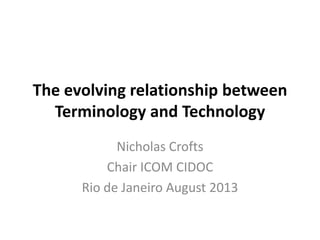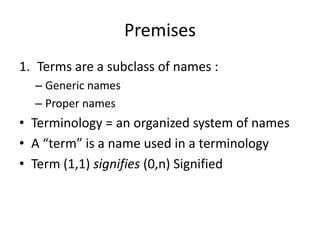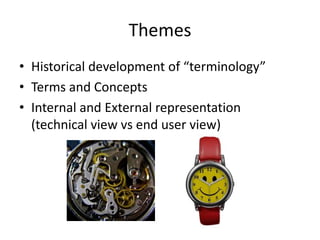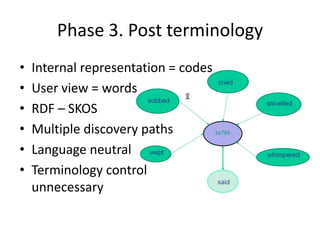Terminology and technology
- 1. The evolving relationship between Terminology and Technology Nicholas Crofts Chair ICOM CIDOC Rio de Janeiro August 2013
- 2. Premises 1. Words are a special case of signs or symbols тАв тАЬany means of expression accepted in a society rests in principle upon a collective habit, or on conventionтАЭ Ferdinand de Saussure, Course in General Linguistics тАв Signifier (1,n) signifies (0,n) Signified
- 3. Premises 1. тАЬFor a large class of casesтАФthough not for allтАФin which we employ the word тАШmeaningтАЩ it can be defined thus: the meaning of a word is its use in the languageтАЭ Ludwig Wittgenstein, Philosophical Investigations тАв Naming is one type of use тАв Not all uses involve namingтАж тАУ and, but, although, however, usually, thereforeтАж тАУ Functional and performative words
- 4. Premises 1. Terms are a subclass of names : тАУ Generic names тАУ Proper names тАв Terminology = an organized system of names тАв A тАЬtermтАЭ is a name used in a terminology тАв Term (1,1) signifies (0,n) Signified
- 5. Themes тАв Historical development of тАЬterminologyтАЭ тАв Terms and Concepts тАв Internal and External representation (technical view vs end user view)
- 6. Phases of terminology 1. Pre terminological 2. Terminological 3. Automation a) Codes for concepts b) Container / content c) Post-terminology
- 7. 1. Pre-terminological тАв Socrates тАж тАУ what is beauty? тАУ what is truth?... тАв not a terminology debate тАв not a system of terms тАв focus is on concepts, the signified тАв Words have ambiguous relations with conceptsтАж тАв 1 word means many things, 1 thing represented by many words
- 8. Jacques-Louis David, La mort de Socrate
- 9. 2. Terminological тАв 18th Century тАж тАУ Enyclopaedias, dictionaries тАв Carl von Linn├й (Linneus) тАУ System of botanical taxonomy тАУ Systematic classification тАв Taxon = a class of objects, not an individual. тАв Unambiguous representation 1 term means 1 thing тАв Term is an identifier Linnaea borealis (twinflower)
- 10. 3. Automated terminology тАв Data = propositions represented in a machine processable form
- 11. Phase 1. Codes = concepts тАв Internal representation = external representation тАв Non human-readable form тАв Code book needed for interpretation тАв Dewey decimal classification тАв Totally unambiguous тАв No misleading connotations тАв Language neutral
- 12. Phase 2: Container/content model тАв тАЬit is important that each user employ the same terms to designate the same type of objects, hence the usefulness of creating a standard vocabularyтАжтАЭ Africom Handbook of Standards тАв Machine readable and human readableтАж тАв CIDOC terminology standards WG тАв Getty AAT, TGN, ULAN Elings, M.W. and Waibel, G. Metadata for allтАж
- 13. Drawbacks тАв Developing a terminology is hard work тАУ AAT 15 year period тАв Inflexible, when terms evolve тАв Natural language is polysemic and ambiguous тАУ Terminology is unnatural language тАв ExpertsтАЩ mind set тАУ Steve project revealed 86% mismatch http://www.museumsandtheweb.com/files/trantSteveResearchReport200 8.pdf тАв Barriers to discovery
- 14. Phase 3. Post terminology тАв Internal representation = codes тАв User view = words тАв RDF тАУ SKOS тАв Multiple discovery paths тАв Language neutral тАв Terminology control unnecessary
- 16. Ontology model took place at had duration Period Place had member had participant Actor Event Individual Group 52 classes ~500тАЩ000 named entities
- 17. Still plenty of workтАж тАв Concept management =/= terminology angst
Editor's Notes
- #4: Not usually encoded in RDF

















